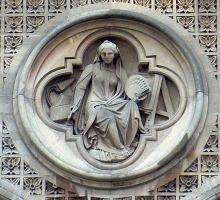
Allegorical statues of Painting are fairly widespread, being associated with galleries and museums across the country, either on their own, or accompanied by Sculpture and perhaps Architecture to make up the Arts. Our allegorical figure is inevitably an artist, most usually with a palette, this being usually of a standard oval shape with a hole, in which the thumb is inserted while the palette is in use, or if not, the brushes may be pushed through it. The example at the top of this page is typical; a seated girl, nicely draped in medieval dress, holding the palette in one hand and clutching a bunch of brushes; her other hand holds a brush ready to paint. Behind her is an easel, another common attribute of Painting, and two books and a curled ream of paper.
Here is another one: a harmoniously draped Classical girl, standing, holding a staff in this case, and in her other hand her palette, thumb through the hole. She is by the illustrious sculptor Sir Richard Westmacott RA, and is one of a small pantheon of the Arts on the pediment of the British Museum.
Here is one more to show the type. Another seated girl, in lighter Classical drapes this time, her hair rather Arts and Crafts, but the Classicism emphasised by the Ionic pillar at her back, and the branch of the olive tree behind her, though this latter also shows Arts and Crafts tendencies in the arrangement of the leaves. Her palette, held in her left hand, is nearly round, and looking closely (you will need to click on the picture to enlarge it), we can discern the blobs of paint upon it. Her other hand holds the brush. We note that her pose is harmonious, and the folds of her drapery form a series of recurring curves, and this tendancy to elegant decoration is a feature of many statues of Painting. We may note in passing that allegorical girls emblematic of Painting are almost never nude, unlike so many other allegorical figures.
Allegorical figures of Painting need not be female: here are examples of male ones. Above left, a small medieval figure, rather in the manner of a Greek hermit, with his loose smock, bare feet, long beard and cap. He holds his palette with a cluster of brushes, and with his other hand he is actually painting on a board. Around him are lively leaves, perhaps hawthorn, treated in a very three dimensional, decorative style. Our second example, terra cotta in relief, is another example of a rather monastic figure, again seated, capped, wearing a smock, and painting a picture, on an easel this time, which we can see to be a portrait in profile. The way he is sitting means we cannot see his palette, unusually, but the cluster of brushes which are presumably in his other hand are lightly sketched in. He could be medieval rather than Classical, except that his seat is the capital of a Corinthian pillar.
Such hermit like bearded and capped men are something of a convention for male representations of Painting – above left is another example, yet again seated, this time with palette and brushes visible, and painting on some large canvas. I chose this one as a clearly medieval example, with no hint of the Classical. The artist above right, though, has a moustache but no beard, and no cap, and figure-hugging rather than voluminous smock. He sits on an ornamented stool. No palette can be seen, but he is painting a portrait of a man on an easel. His other hand holds a long staff as we have seen before.
We can have cherubs as allegories of Painting too. Above left is a truly fat little thing, naked and bloated, sitting at an easel with palette and long brush; on the table behind him are his other brushes and a bottle of turpentine or some other solvent to thin his paint. Above right is a kneeling cherub, holding his palette, and perhaps brushes in his other hand, while his companion reclines with an unrolled scroll. If you like cherubic figures, there are a variety on this page.
This then brings us on to cases where our allegorical figure of Painting is part of a group. Above left is an example of the Arts. Painting is on the right, Architecture is central, and Sculpture is on the left. This lovely example of Arts and Crafts sculpture is from the former Gaiety Theatre on Aldwych in London. The next example has Painting as the central figure in a longer line up of the Arts, including Music, Poetry, Pottery and Metalwork. And to the right, something rather different: Painting is seated, her palette on the floor behind her, brush in hand sketching on a tablet, and accompanied by a young boy holding further canvas. As previously, Painting has most harmonious drapery; this time in a Hellenistic mode. John Henning was the sculptor, and this is one of his group of panels for Manchester Art Gallery.
The example above is a rare case of Painting reduced to a head, a palette and brushes. The harmony of drapery is here replaced by elegantly flying ribbons, and flowers and fruit; she wears an olive wreath in her hair, recalling the sprig of olive we noted behind the figure further up this page. The face, utterly Arts and Crafts, is of particular beauty.
Finally, we end this page with another standing girl, this one perhaps the largest example of an allegorical statue showing Painting and Sculpture together, personifying the Arts, who is nearly 15 ft high from base to the crown of her head. She is of course one of the figures on Vauxhall Bridge in London, by Alfred Drury.
Back to Allegorical sculpture - O // Onward to Allegorical sculpture - R // Full Alphabet of Allegorical sculpture
Sculpture in England // Sculptors
Visits to this page from 12 Jan 2014: 5,888